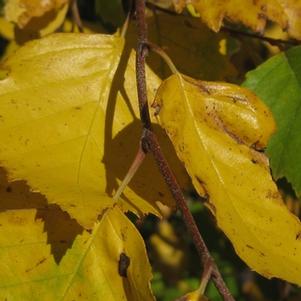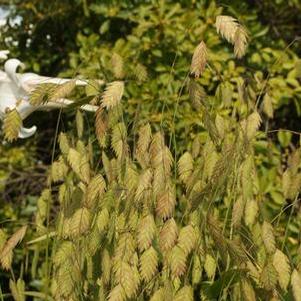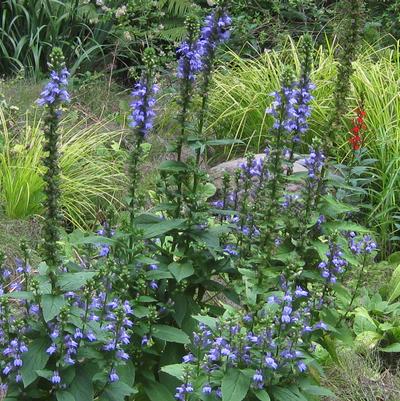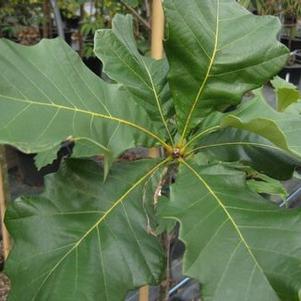Wet Loving Natives
You may or may not have been blessed with a fair amount of summer precipitation lately. Despite this year’s earlier drought, we’ve been making up for the rain loss with near-nightly summer storms. In honor of the rain gods, this week we’ll be talking about a handful of natives that prefer moist soil conditions, and the integral ecosystem services that each is responsible for.
Lobelia siphilitica
First up, Lobelia siphilitica is a fairly celebrated wet-loving perennial that produces indigo blue lipped flowers that are known to attract hordes of pollinators, including skippers, various bee and butterfly species, and Ruby-throated hummingbirds. Besides the blue flowers adding a unique pop of color to the wet meadow, they tend to deter both rabbits and deer due to the presence of mildly toxic alkaloids – meaning more lovely blue hues for you and the pollinators. Despite these alkaloids, various Native American tribes traditionally utilized blue lobelia to treat an assortment of ailments, including respiratory conditions and headaches. The Meskwaki, who we’ve mentioned in a previous email because of their relationship to Eryngium yuccifolium, also had a specific use for blue lobelia: when consumed by an unknowing husband and wife (read: when snuck into their food), the mashed roots of the plant were said to strengthen their union and act as an anti-divorce remedy. While we don’t recommend harvesting and munching on Lobelia siphilitica roots in an effort to save your marriage, we DO recommend using them for preventing soil erosion and helping to stabilize areas that receive high levels of water inundation. This highly adaptable plant thrives in both disturbed areas as well as well-established zones with late-successional species. Capable of existing in full sun where soils are consistently moist, or in partial shade where soils may be slightly drier, this blue-bloomer is sure to attract no shortage of interesting insects to the garden. In a Michigan State University trial, researchers counted more than five different bee species visiting Lobelia siphilitica in a 30-second interval, and also found that it is highly attractive to late season beneficial predators such as chalcid wasps (Chalcidoidea), soldier beetles (Cantharidae), and ladybugs (Coccinellidae).
Chasmanthium latifolium
While Lobelia siphilitica will naturalize itself to a somewhat minimal degree, native grass Chasmanthium latifolium will give you the coverage you’re not only hoping for, but coverage you didn’t even know you needed. A vigorous spreader, our Northern Sea Oats will happily take over both full sun to partial shade areas where soil variability may be a constant issue. No-fear-Chasmanthium latifolium is capable of handling not only wet sites, but also periods of drought in the event that it is situated in enough shade that it won’t succumb completely. As its common name implies, the attractive seedheads resemble sea oats, although they should probably be referred to more often as river oats or wood oats due to their typical natural distribution. The seedheads, which appear in mid-to-late summer (ours started appearing several weeks ago), persist throughout the fall into the winter, often taking on an attractive autumnal palette and giving textural interest to the garden in the later months when there isn’t much to look at. While not technically an actual “oat”, which belong to the genus Avena, wood oats/river oats/Northern sea oats can be similarly processed for culinary uses; primarily, they can be used as a cereal grain and ground for flour production. While you are more than capable of enjoying your wood oats for your own tasty uses, we also recommend planting this adaptable grass for its ecological services and high value to native fauna. Chasmanthium latifolium is known to be a larval host for a handful of skipper butterfly species as well as the Northern Pearly-Eye caterpillar, whose chartreuse epidermis camouflages almost perfectly into wood oats’ strappy leaf blades.
Quercus bicolor
While we’re on the topic of highly valuable ecosystem services, we’re going to transition from oats to oaks: specifically, Swamp White Oak, Quercus bicolor. What better to create a shady oasis for your wood oats than by incorporating a dutiful shade tree such as the Swamp white oak? Standing below one of these majestic trees and being embraced by its leaves caught in a breeze (when paired with the gentle chiming of wood oats) is sure to provide a wonderful sensory experience to the garden visitor. Dark, glossy green leaves reveal pale, silvery undersides when tickled by the wind, giving this lovely shade tree its specific epithet. Due to its somewhat limited distribution in the wild, Quercus bicolor stands to become a long-lived staple in the garden so long as it has moist, somewhat acidic soils in which to thrive. Like other native Quercus, the acorns provide critical nutrients for forest-dwelling mammals such as deer, turkeys, squirrels and other small rodents, as well as wild ducks: a Wisconsin study found that the acorns of Swamp White Oak made up approximately 27% of the diet of wild ducks, while its broad, rounded form, large foliage and zig-zagging branches provides necessary shelter for a multitude of non-game birds. While we offer the straight species form, we also offer a columnar selection, Quercus bicolor Beacon® (‘Bonnie and Mike’), named after Mike Dirr and his wife Bonnie who discovered this form in the Shenandoah Valley of Virginia. A perfect oak specimen for wet areas where lateral space may be limited, Beacon® typically reaches a height of 50’ and an overall width of 15’, while its predecessor typically reaches a height of 70’ and a width closer to 50’.
Betula nigra
Continuing forward with wet-loving native trees, the North American native River Birch, Betula nigra is as ornamentally interesting as it is versatile in the landscape. Known for being one of the most heat tolerant birches, as well as compaction tolerant and capable of handling periods of drought, Betula nigra can be used not only in the wetland or rain garden, but can be an adaptable tree for urban sites as well so long as it receives adequate moisture wherever it’s situated. Beautiful exfoliating young bark exhibits a mixture of red, brown, grey and sienna, adding both texture and color to the winter landscape. River birches should be considered not just for their ornamental stronghold in the garden, though – they are thought to be a critical resource for a wide range of animals, from birds, rodents, and deer which consume the twigs, buds, foliage, catkins and seeds, to Eastern Tiger Swallowtails, Mourning Cloak and Dreamy Duskywing butterflies, which use river birches as a host plant. Currently, we have several sizeable crops of Betula nigra ‘Cully’ Heritage® available. This selection is known for taking all of the river birch’s already highly ornamental attributes to the next level, with even peelier, salmon-colored outer bark that reveals cream-colored inner bark as it exfoliates.
Anderson, M. K. (2003, March 21). Great Blue Lobelia | Lobelia siphilitica L. Plant Guide. https://citeseer.ist.psu.edu/
Campbell, S., & Yiesla, S. (2022, March 31). River birch. The Morton Arboretum. https://mortonarb.org/plant-and-protect/trees-and-plants/river-birch/
Deane, G. (2017, September 11). Wood Oats. Eat The Weeds and other things, too. https://www.eattheweeds.com/chasmanthium-latifolium-edible-wood-oats-2/
Dirr, M. (2022, July 8). Dr. Dirr’s Tree spotlight: Quercus bicolor. HMI Advantage. https://www.hmiadvantage.com/dr-dirrs-tree-spotlight-quercus-bicolor/
Gilman, E. F., & Watson, D. G. (1993, November). Betula nigra ‘Heritage’ - University of Florida. Tree Fact Sheets. https://hort.ifas.ufl.edu/database/documents/pdf/tree_fact_sheets/betnigb.pdf
Hilty, J. (2019). Great Blue Lobelia (lobelia siphilitica). https://www.illinoiswildflowers.info/wetland/plants/gb_lobeliax.htm
ISU Extension and Outreach. (n.d.). Swamp white oak. Natural Resource Stewardship. https://naturalresources.extension.iastate.edu/forestry/iowa_trees/trees/swamp_white_oak.html
Master Gardeners of Northern Virginia. (2022, February 20). Chasmanthium latifolium (river or wild oats, Northern Sea Oats). Master Gardeners of Northern Virginia. https://mgnv.org/plants/native-plants/grasses/chasmanthium-latifolium/
Minnesota DNR. (2023, January 19). Swamp White Oak (Quercus bicolor). Minnesota Department of Natural Resources. https://www.dnr.state.mn.us/trees/swamp-white-oak.html
Missouri Botanical Garden. (n.d.). Betula nigra “Cully” HERITAGE. Betula nigra “Cully” heritage - plant finder. https://www.missouribotanicalgarden.org/PlantFinder/PlantFinderDetails.aspx?kempercode=a200
MSU. (n.d.). Native Plant Facts: Blue Lobelia - College of agriculture and natural ... Native Plants and Ecosystem Services. https://www.canr.msu.edu/nativeplants/uploads/files/Blue_lobelia.pdf
National Gardening Association. (n.d.). Great Blue Lobelia (lobelia siphilitica) - garden.org. Plants Database. https://garden.org/plants/view/77613/Great-Blue-Lobelia-Lobelia-siphilitica/
NC State Extension. (n.d.-a). Betula nigra. Betula nigra (Black Birch, Red Birch, River Birch, Water Birch) | North Carolina Extension Gardener Plant Toolbox. https://plants.ces.ncsu.edu/plants/betula-nigra/
NC State Extension. (n.d.-b). Inland Sea Oats Chasmanthium latifolium. Inland Sea Oats - Chasmanthium latifolium | North Carolina Extension Gardener Plant Toolbox. https://plants.ces.ncsu.edu/plants/chasmanthium-latifolium/common-name/inland-sea-oats/
Rogers, R. (n.d.). Quercus bicolor Willd. | Swamp White Oak. Quercus bicolor WiIId. https://www.srs.fs.usda.gov/pubs/misc/ag_654/volume_2/quercus/bicolor.htm
Taylor, D. (n.d.). Plant of the Week: Great Blue Lobelia (Lobelia siphilitica). U.S. Forest Service. https://www.fs.usda.gov/wildflowers/plant-of-the-week/lobelia_siphilitica.shtml
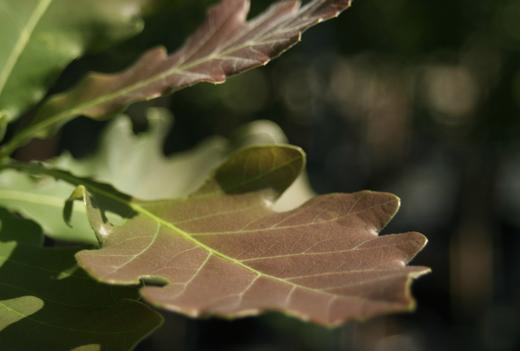
Quercus bicolor


